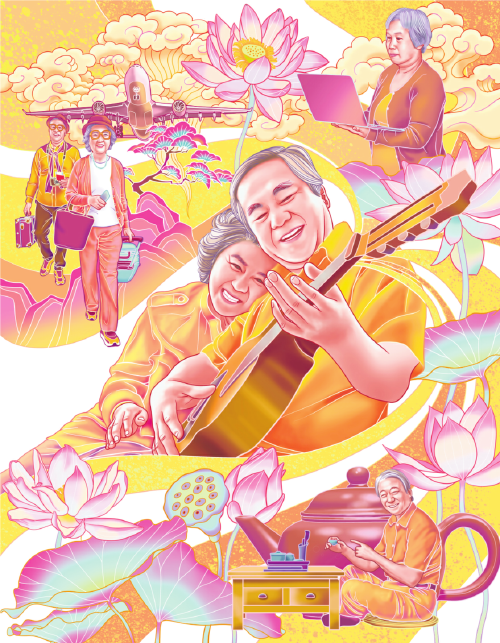Steps taken to drive silver economy
Guideline urges support for businesses catering to elderly population
By WANG KEJU | CHINA DAILY | Updated: 2024-02-07 08:39

In response to the profound demographic changes and the increasing proportion of elderly citizens the country is seeing, China has put the development of the silver economy high on its work agenda and has taken a series of steps to create an enabling environment for businesses to cater to the unique demands of the aging population.
The forward-looking initiative will not only deliver immediate benefits to ensure the well-being and dignity of older adults, but also yield long-term economic gains that will foster new drivers of development, officials and experts said.
Their comments came after the State Council, China's Cabinet, rolled out a guideline in January to develop the silver economy and improve the livelihoods of seniors — the country's first well-focused policy framework on this front.
The guideline defines the silver economy as a collective term encompassing a series of economic activities aimed at providing products or services to older adults and helping citizens prepare for their twilight years.
The silver economy is characterized by its massive consumer base, extensive industry chains and diverse business models, which cover the primary, secondary and tertiary sectors, said Zhang Shixin, deputy secretary-general of the National Development and Reform Commission, the country's top economic planning agency.
Data released by the National Bureau of Statistics showed that there were 296.97 million people age 60 and above in China by the end of last year, accounting for about 21 percent of the population. The number of people age 65 and above hit 216.76 million, or 15.4 percent of the population.
The sheer size of China's senior population translates into a vast market with considerable purchasing power. As people live longer and healthier lives, their demand for specific products and services increases, potentially sparking the creation of a multitude of new businesses, said Li Jia, deputy head of the Aging Society Research Center at the Pangoal Institution.
By 2035, the scale of China's silver economy will reach an estimated 19 trillion yuan ($2.9 trillion), accounting for 28 percent of the country's total consumption and 9.6 percent of national GDP, according to a report released by the Fudan Institute of Aging in Shanghai.
The guideline says China will establish some 10 high-level silver economy industrial parks in key regions, including the Beijing-Tianjin-Hebei region, the Yangtze River Delta, the Guangdong-Hong Kong-Macao Greater Bay Area and the Chengdu-Chongqing economic circle.
Addressing urgent concerns and expanding essential services for the elderly will be prioritized to create a supportive environment for the nation's aging population, with dedicated efforts channeled to expanding welfare canteen programs, enhancing home-based elderly care accessibility, optimizing senior health services and bridging gaps between urban and rural areas, the guideline said.
By the end of 2022, China had 387,000 elderly care facilities providing a combined 8.29 million beds, according to data from the Ministry of Civil Affairs.
"However, tackling the urban-rural imbalance in elderly care services is a priority for the government, as rural areas face challenges due to the lack of sufficient facilities and lower quality standards," said Chen Gong, director of the Population Research Institute at Peking University.
The government should develop and implement policies that specifically target the urban-rural divide, including financial incentives for care providers to establish facilities in rural areas, regulatory frameworks to ensure quality standards are met, and measures to encourage healthcare professionals to work in rural areas, Chen added.
Despite the growth of basic services industries such as hospitality and healthcare catering to the elderly population, the diverse, differentiated and personalized needs of older adults are increasingly becoming more pronounced and urgent, analysts said.
They belong to different generations, have varying levels of physical and cognitive abilities, and may come from different cultural and socioeconomic backgrounds, representing different needs and desires, said Lou Feipeng, a researcher at the Postal Savings Bank of China.
The demographic shift and improvements in living standards have resulted in a stronger desire among older adults to enhance their overall well-being and enjoy a higher quality of life. This trend is particularly notable among the post-1960 generation, who have experienced societal and economic changes throughout their lives and hold different expectations compared to previous generations, Lou added.
According to a survey conducted by the People's Bank of China, the country's central bank, residents age 56 to 64 hold more assets compared to other age brackets, positioning them as a key demographic in the silver economy market.
The survey also revealed that there was a notable shift in consumer behavior and preferences for the aging population between 2014 and 2020, with older adults increasing their investments in social engagement, healthcare and retirement financial services.
To this end, seven key industries with high growth potential have been identified in the guideline, ranging from goods favored by the elderly and smart healthcare products to anti-aging solutions, retirement financial services and senior-friendly tourism.
For instance, by leveraging emerging technologies such as the internet of things, cloud computing, big data and smart hardware, the country aims to provide intelligent products and services that cater to the various needs of older adults, said Liu Ming, director of the commission's department of social development.
In the long run, China should champion the idea of age inclusivity and advocate for universal concepts that transcend age barriers, creating a more age-inclusive socioeconomic environment, said Hu Zushuan, a researcher with the economic forecast department of the State Information Center of China.
To achieve this vision, China should continue to promote the construction of infrastructure that is barrier free and the development of a more senior-friendly society. To that end, efforts are being made to ensure that public spaces, retail outlets, hotels, cultural venues, tourism destinations and sports facilities are accessible and accommodating to people of all ages, Hu added.
As China recognizes the immense potential of the silver economy, it is crucial to acknowledge the challenges that hinder its development. Currently, the country faces issues such as a shortage of specialized talent, a lack of investment motivation and inadequate policy support for certain industries, analysts said.
A survey conducted by the China Research Center on Aging in Beijing indicated that the elderly care service sector is grappling with several pressing issues, including low wages, a scarcity of skilled professionals, and a lack of stability within the workforce.
Addressing this challenge requires the development of training programs, educational initiatives and incentives to attract and retain talent that are key to the silver economy sector, said Xu Hongcai, deputy director of the China Association of Policy Science's Economic Policy Committee.
wangkeju@chinadaily.com.cn
























